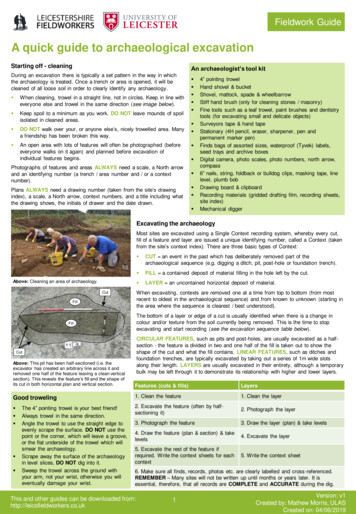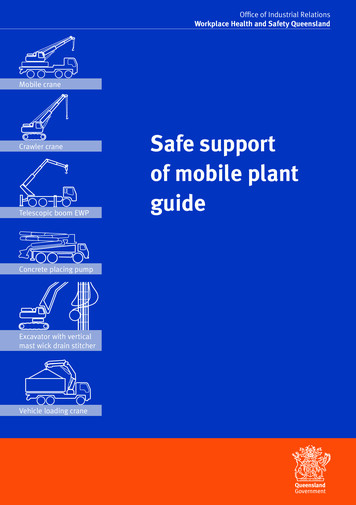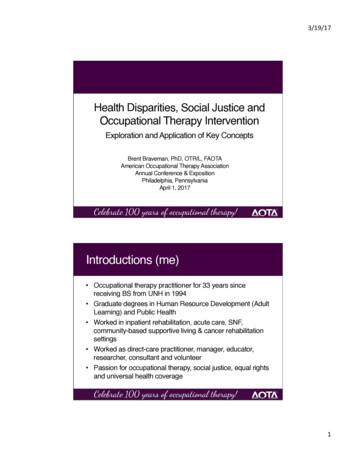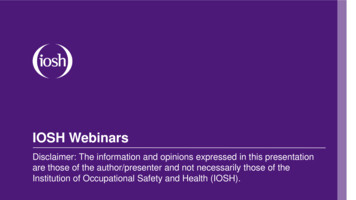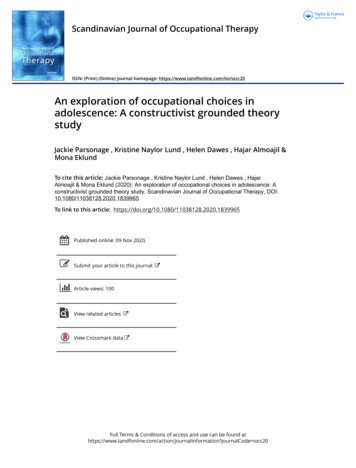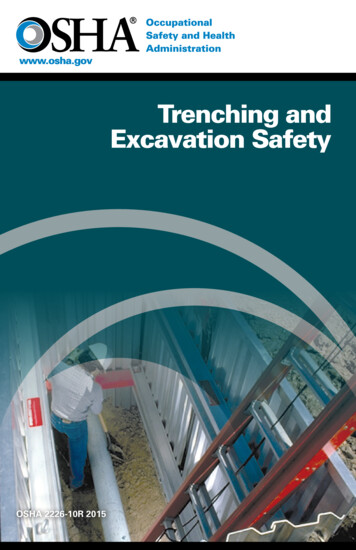
Transcription
Trenching andExcavation SafetyOSHA 2226-10R 2015
Occupational Safety and Health Act of 1970“To assure safe and healthful working conditions forworking men and women; by authorizing enforcementof the standards developed under the Act; by assistingand encouraging the States in their efforts to assuresafe and healthful working conditions; by providing forresearch, information, education, and training in the fieldof occupational safety and health.”Material contained in this publication is in the public domainand may be reproduced, fully or partially, without permission.Source credit is requested but not required.This information will be made available to sensory-impairedindividuals upon request. Voice phone: (202) 693-1999;teletypewriter (TTY) number: 1-877-889-5627.This publication is intended to provide information aboutOSHA’s Excavations standards at 29 CFR Part 1926, Subpart P.The Occupational Safety and Health Act requires employers tocomply with safety and health standards promulgated by OSHAor by a state with an OSHA-approved state plan. However, thispublication is not itself a standard or regulation, and it creates nonew legal obligations.Cover photo courtesy of Speed Shore Corp.
Trenching and Excavation SafetyU.S. Department of LaborOccupational Safety and Health AdministrationOSHA 2226-10R 2015
Table of ContentsIntroduction . . . . . . . . . . . . . . . . . . . . . . . . . . . . . . . . . . . . . . . . . . . 1What is the difference between an excavationand a trench?. . . . . . . . . . . . . . . . . . . . . . . . . . . . . . . . . . . . . . . . . 1What are the dangers of trenching andexcavation operations?. . . . . . . . . . . . . . . . . . . . . . . . . . . . . . . . . 1What do the OSHA Excavation standards cover,and how do they protect workers?. . . . . . . . . . . . . . . . . . . . . . . 1What are the soil classification categories?. . . . . . . . . . . . . . . . 2What is a competent person? . . . . . . . . . . . . . . . . . . . . . . . . . . . 3Preplanning. . . . . . . . . . . . . . . . . . . . . . . . . . . . . . . . . . . . . . . . . . . . 3Why is preplanning important to excavation work?. . . . . . . . . 3What safety factors should be considered whenbidding on a job?. . . . . . . . . . . . . . . . . . . . . . . . . . . . . . . . . . . . . . 4How can employers avoid hitting undergroundutility lines and pipes during excavation work? . . . . . . . . . . . . 4Protective Systems . . . . . . . . . . . . . . . . . . . . . . . . . . . . . . . . . . . . . 5How can employers prevent cave-ins?. . . . . . . . . . . . . . . . . . . . 5What types of protective systems can employersuse to protect workers from cave-ins?. . . . . . . . . . . . . . . . . . . . 5What other precautions do employers need totake to protect workers from cave-ins? . . . . . . . . . . . . . . . . . . . 7What are the requirements for safely installingand removing protective systems?. . . . . . . . . . . . . . . . . . . . . . . 8What do employers need to do to maintain materialsand equipment used for protective systems?. . . . . . . . . . . . . . 9Additional Hazards and Protections. . . . . . . . . . . . . . . . . . . . . . . 9What other excavation hazards do employersneed to address?. . . . . . . . . . . . . . . . . . . . . . . . . . . . . . . . . . . . . . 9What is the effect of water accumulation onexcavation safety and what do employers need to do toprotect workers from water-related excavation hazards?. . . 10How can employers protect workers from hazardousatmospheres inside excavations?. . . . . . . . . . . . . . . . . . . . . . . . 11
What means of access and egress mustemployers provide?. . . . . . . . . . . . . . . . . . . . . . . . . . . . . . . . . . . 12What protective equipment are employersrequired to provide to workers in pier holes andconfined footing excavations?. . . . . . . . . . . . . . . . . . . . . . . . . . 12When must employers conduct site inspections? . . . . . . . . . 12Conclusion. . . . . . . . . . . . . . . . . . . . . . . . . . . . . . . . . . . . . . . . . . . . 13Workers’ Rights . . . . . . . . . . . . . . . . . . . . . . . . . . . . . . . . . . . . . . . . 14OSHA Assistance, Services and Programs . . . . . . . . . . . . . . . . . . 14Establishing an Injury and Illness Prevention Program. . . . . 15Compliance Assistance Specialists . . . . . . . . . . . . . . . . . . . . . 15Free On-site Safety and Health Consultation Servicesfor Small Business. . . . . . . . . . . . . . . . . . . . . . . . . . . . . . . . . . . . . . . . 15Cooperative Programs. . . . . . . . . . . . . . . . . . . . . . . . . . . . . . . . 16Occupational Safety and Health Training. . . . . . . . . . . . . . . . . 17OSHA Educational Materials. . . . . . . . . . . . . . . . . . . . . . . . . . . 17NIOSH Health Hazard Evaluation Program . . . . . . . . . . . . . . . . 18OSHA Regional Offices. . . . . . . . . . . . . . . . . . . . . . . . . . . . . . . . . 19How to Contact OSHA. . . . . . . . . . . . . . . . . . . . . . . . . . . . . . . . . . 21
IntroductionExcavation and trenching are among the most hazardousconstruction operations. The Occupational Safety and HealthAdministration’s (OSHA) Excavation standards, 29 Codeof Federal Regulations (CFR) Part 1926, Subpart P, containrequirements for excavation and trenching operations. Thisbooklet highlights key elements of the standards and describessafe work practices that can protect workers from cave-ins andother hazards.What is the difference between an excavationand a trench?OSHA defines an excavation as any man-made cut, cavity, trench,or depression in the Earth’s surface formed by earth removal.A trench is defined as a narrow excavation (in relation to its length)made below the surface of the ground. In general, the depthof a trench is greater than its width, but the width of a trench(measured at the bottom) is not greater than 15 feet (4.6 m).What are the dangers of trenching andexcavation operations?Trenching and excavation work presents serious hazards to allworkers involved. Cave-ins pose the greatest risk and are morelikely than some other excavation-related incidents to result inworker fatalities. One cubic yard of soil can weigh as much as acar. An unprotected trench can be an early grave. Employers mustensure that workers enter trenches only after adequate protectionsare in place to address cave-in hazards. Other potential hazardsassociated with trenching work include falling loads, hazardousatmospheres, and hazards from mobile equipment.What do the OSHA Excavation standards cover,and how do they protect workers?The standards apply to all open excavations made in the Earth’ssurface, including trenches. Following the requirements of thestandards will prevent or greatly reduce the risk of cave-ins andother excavation-related incidents.Trenching and Excavation Safety1
What are the soil classification categories?Some of the compliance methods permitted under theExcavation standards require a competent person to classifysoil and rock deposits as: Stable rock; Type B soil; or Type A soil; Type C soil.See Appendix A to Subpart P of Part 1926 – Soil Classification.Stable Rock – Natural solid mineral matter that can beexcavated with vertical sides and remain intact while exposed.Type A – Cohesive soils with an unconfined compressivestrength of 1.5 tons per square foot (tsf) (144 kPa) or greater.Examples include: clay, silty clay, sandy clay, and clay loam.Certain conditions preclude soil from being classified as TypeA. For example, no soil is Type A if it is fissured or has beenpreviously disturbed. See Appendix A to Subpart P of Part 1926,paragraph (b) – Definitions (Type A), for a detailed definition ofType A soil.Type B – Includes cohesive soil with an unconfined compressivestrength greater than 0.5 tsf (48 kPa) but less than 1.5 tsf (144kPa) and granular cohesionless soils (such as angular gravel,similar to crushed rock, silt, silt loam, sandy loam, and, in somecases, silty clay loam and sandy clay loam). See Appendix A toSubpart P of Part 1926, paragraph (b) — Definitions (Type B), fora detailed definition of Type B soil.Type C – Cohesive soil with an unconfined compressivestrength of 0.5 tsf (48 kPa) or less, granular soils (includinggravel, sand, and loamy sand), submerged soil or soil fromwhich water is freely seeping, submerged rock that is notstable, or material in a sloped, layered system where the layersdip into the excavation or with a slope of four horizontal to onevertical (4H:1V) or steeper. See Appendix A to Subpart P ofPart 1926, paragraph (b) — Definitions (Type C), for a detaileddefinition of Type C soil.Occupational Safety and Health Administration2
Note: Unconfined compressive strength means the load perunit area at which a soil will fail in compression. It can bedetermined by laboratory testing or estimated in the field usinga pocket penetrometer,thumb penetration tests,or other methods.See the video link belowfor additional guidance onclassifying soil: www.osha.gov/dts/vtools/construction/soil testing fnl eng web.html.What is a competent person?A competent person is an individual, designated by the employer,who is capable of identifying existing and predictable hazardsin the surroundings or working conditions which are unsanitary,hazardous or dangerous to workers, and who is authorized totake prompt corrective measures to eliminate them.Under the Excavation standards, tasks performed by thecompetent person include: Classifying soil; Inspecting protectivesystems;Monitoring water removalequipment; and Conducting siteinspections. Designing structural ramps;PreplanningWhy is preplanning important toexcavation work?No matter how many trenching, shoring, and backfilling jobs anemployer has done in the past, it is important to approach eachnew job with care and preparation. Many on-the-job incidentsresult from inadequate initial planning. Waiting until after theTrenching and Excavation Safety3
work starts to correct mistakes in shoring or sloping slowsdown the operation, adds to the cost of the project, and makesa cave-in or other excavation failure more likely.What safety factors should be considered whenbidding on a job?Before preparing a bid, employers should know as much aspossible about the jobsite and the materials they will need to haveon hand to perform the work safely and in compliance with OSHAstandards. A safety checklist may prove helpful when employersare considering new projects. Factors to consider may include: Traffic Weather Proximity and physicalcondition of nearbystructures Quantity of shoring orprotective systems thatmay be required Soil classification Fall protection needs Surface and ground water Location of the water tableNumber of ladders that maybe needed Overhead andunderground utilities Other equipment needs.Employers can gather the information they need through jobsitestudies, observations, test borings for soil type or conditions,and consultations with local officials and utility companies. Thisinformation will help employers determine the amount, kind, andcost of safety equipment they will need to perform the work safely.How can employers avoid hitting undergroundutility lines and pipes during excavation work?Before starting work, the Excavation standards requireemployers to do the following: Determine the approximate location(s) of utility installations —including sewer, telephone, fuel, electric, and water lines.One common industry practice is to call 811, the “CallBefore You Dig” number, to establish the location of anyunderground utility installations in the work area.Occupational Safety and Health Administration4
Contact and notify the utility companies or owners involvedto inform them of the proposed work within established orcustomary local response times. Ask the utility companies or owners to establish the locationof underground installations prior to the start of excavationwork. If they cannot respond within 24 hours (unless theperiod required by state or local law is longer) or cannotestablish the exact location of the utility installations,employers may proceed with caution, which includes usingdetection equipment or other acceptable means to locateutility installations. Determine the exact location of underground installationsby safe and acceptable means when excavation operationsapproach the approximate location of the installations. Ensure that while the excavation is open, undergroundinstallations are protected, supported or removed asnecessary to safeguard workers.Protective SystemsHow can employers prevent cave-ins?OSHA generally requires that employers protect workers fromcave-ins by: Sloping and benching the sides of the excavation; Supporting the sides of the excavation; or Placing a shield between the side of the excavation and thework area.What types of protective systems can employersuse to protect workers from cave-ins?In many cases the type of protective system needed is wellknown and simple to use. At other times employers willundertake the more complex process of designing a protectivesystem. Designing a protective system requires considerationof many factors, including: soil classification, depth of cut,water content of soil, weather and climate, and other operationsTrenching and Excavation Safety5
in the vicinity. Employers are free to choose the most practicaldesign that will provide the necessary protections. Any systemused must meet the required performance criteria.The Excavation standards describe various methods andapproaches that can be used to design protective systems.Examples of protective systems that can be used to complywith the Excavation standards include: Sloping the sides of the excavation to an angle not steeperthan 1½:1 (for every foot of depth, the trench must beexcavated back 1½ feet). A slope of this gradation is safe forany type of soil.Figure 1. Slope of 1½:1 Designing a sloping and benching system in accord withtabulated data, such as tables and charts, approved bya registered professional engineer. This data must be inwriting and must include enough explanatory information(including the criteria for selecting a system and the limitson the use of the data) for the user to be able to select anappropriate protective system. At least one copy of the data,which identifies the registered professional engineer whoapproved it, must be kept at the worksite during constructionof the protective system. After the system is completed, thedata may be stored away from the jobsite, but a copy mustbe provided upon request to an OSHA compliance officer. Using a trench box or shield approved by a registeredprofessional engineer or designed in accord with tabulateddata approved by a registered professional engineer.Occupational Safety and Health Administration6
Figure 2. Trench ShieldsThe Excavation standards do not require a protective systemwhen an excavation is made entirely in stable rock or whenan excavation is less than 5 feet (1.52 meters) deep and acompetent person has examined the ground and found noindication of a potential cave-in.What other precautions do employers need totake to protect workers from cave-ins?The Excavation standards require employers to providesupport systems, such as shoring, bracing, or underpinning,when necessary to ensure that adjacent structures (includingadjoining buildings, walls, sidewalks and pavements) remainstable for the protection of workers. The standards also prohibitexcavation below the base or footing of any foundation orretaining wall that could be reasonably expected to pose ahazard to workers unless: The employer provides a support system, such asunderpinning; The excavation is in stable rock; orTrenching and Excavation Safety7
A registered professional engineer determines that thestructure is far enough away from the excavation that itwould not be affected by the excavation activity or that theexcavation work will not pose a hazard to workers.Excavations that would undermine sidewalks, pavement, andappurtenant structures are prohibited unless the employerprovides an appropriately designed support system or anothereffective method of protecting workers from the possiblecollapse of those structures.What are the requirements for safely installingand removing protective systems?The Excavation standards require employers to take certainsteps to protect workers when installing and removing supportsystems. For example: Members of support systems must be securely connected toprevent sliding, falling, kickouts or predictable failure. Support systems must be installed and removed in a mannerthat protects workers from cave-ins and structural collapsesand from being struck by members of the support system. Members of support systems must not be overloaded. Before temporary removal of individual members, additionalprecautions are required, such as installing other structuralmembers to carry loads imposed on the support system. Removal must begin at, and progress from, the bottom ofthe excavation. Backfilling must progress together with the removal ofsupport systems from excavations.In addition, the standards permit excavation of 2 feet (0.61meters) or less below the bottom of the members of a supportsystem, but only if the system is designed to resist the forcescalculated for the full depth of the trench and there are noindications, while the trench is open, of a possible loss ofsoil from behind or below the bottom of the support system.Employers must coordinate the installation of support systemswith the excavation work.Occupational Safety and Health Administration8
What do employers need to do tomaintain materials and equipment usedfor protective systems?Employers are responsiblefor maintaining materials andequipment used for protectivesystems. Defective and damagedmaterials and equipment can causeprotective systems to fail andlead to other excavation hazards.Employers must ensure that: Materials and equipment are free from damage or defectsthat might impair their proper function; Manufactured materials and equipment are usedand maintained consistent with the manufacturer’srecommendations and are used so as to prevent workerexposure to hazards; A competent person examines any damaged materials orequipment to evaluate its suitability for continued use; and If a competent person cannot assure that damaged materialor equipment can support the intended loads or is otherwisesuitable for use, the materials and equipment are removedfrom service until evaluated and approved by a registeredprofessional engineer.Additional Hazards and ProtectionsWhat other excavation hazards do employersneed to address?In addition to cave-ins and related hazards, workers involved inexcavation work are exposed to hazards involving falling loadsand mobile equipment. To protect workers from these hazards,OSHA requires employers to take certain precautions. Forexample, employers must: Protect workers from excavated or other materials orequipment that could pose a hazard by falling or rollingTrenching and Excavation Safety9
inside the excavation by placing and keeping such materialsor equipment at least 2 feet (0.61 meters) from the edgeand/or by using a retaining device to keep the materials orequipment from falling or rolling into the excavation. Provide a warning system (such as barricades, hand ormechanical signals, or stop logs) when mobile equipment isoperated adjacent to an excavation, or when such equipmentmust approach the edge of an excavation, and the operatordoes not have a clear and direct view of the edge. Protect workers from loose rock or soil that could fall or rollfrom an excavation face by scaling to remove loose material,installing protective barricades at appropriate intervals, orusing other equivalent forms of protection. Institute and enforce work rules prohibiting workers fromworking on faces of sloped or benched excavations at levelsabove other workers unless the workers at the lower levelsare adequately protected from the hazards of falling, rolling,or sliding material or equipment. Institute and enforce work rules prohibiting workers fromstanding or working under loads being handled by lifting ordigging equipment. Require workers to stand away from vehicles being loadedor unloaded to protect them from being struck by anyspillage or falling materials. (Operators may remain insidethe cab of a vehicle being loaded or unloaded if the vehicleis equipped, in accord with 29 CFR 1926.601(b)(6), to provideadequate protection for the operator.)What is the effect of water accumulation onexcavation safety and what do employers needto do to protect workers from water-relatedexcavation hazards?Water in an excavation can undermine the sides of theexcavation and make it more difficult for workers to get outof the excavation. The OSHA standards prohibit employersfrom allowing workers to enter an excavation where water hasaccumulated or is accumulating unless adequate precautions aretaken to protect workers. Such precautions can include specialOccupational Safety and Health Administration1 0
support or shield systems to prevent cave-ins, water removal tocontrol the water level, or the use of a safety harness and lifeline.If an employer uses water removal equipment to control orprevent water accumulation, the equipment and operations mustbe monitored by a competent person to ensure proper use. Ifexcavation work interrupts the natural drainage of surface water,the OSHA standards also require the use of diversion ditches,dikes, or other suitable means to prevent surface water fromentering the excavation and to provide adequate drainage ofthe adjacent area. In addition, a competent person must inspectexcavations subject to runoffs from heavy rains, and excavationssubject to such runoffs are subject to the requirements describedpreviously in this paragraph.How can employers protect workers fromhazardous atmospheres inside excavations?Atmospheric testing is required before workers enter anexcavation greater than 4 feet (1.22 meters) in depth where anoxygen deficiency or a hazardous atmosphere is present orcould reasonably be expected, such as in excavations in landfillareas or excavations in areas where hazardous substances arestored nearby. If there are any hazardous conditions present,the employer must ensure that adequate precautions aretaken to prevent employee exposure to those conditions. Suchprecautions include providing workers with proper respiratoryprotection or ventilation. In addition, when controls are usedto reduce the level of atmospheric contaminants to acceptablelevels, testing must be conducted as often as necessary toensure that the atmosphere remains safe.If hazardous atmospheric conditions exist or may reasonablybe expected to develop in an excavation, the employer mustensure the ready availability of emergency rescue equipment,such as breathing apparatus, a safety harness and line, or abasket stretcher. This equipment must be attended when in use.Note: In addition to the Excavation standards’ provisions onhazardous atmospheres in excavations, OSHA’s Confined Spacesin Construction standard (29 CFR Part 1926, Subpart AA) appliesto non-excavation work within a confined space located in anTrenching and Excavation Safety1 1
excavation. These standards are intended to complement eachother and address two distinct hazards: hazardous atmospheresin excavations and the additional hazards associated withconfined spaces located within excavations. For example, theConfined Spaces in Construction standard covers entry into aprefabricated storm drain, other pipe, or manhole even if locatedat the bottom of an open excavation.What means of access and egress mustemployers provide?OSHA requires employers to provide ladders, steps, ramps,or other safe means of egress for workers working in trenchexcavations 4 feet (1.22 meters) or deeper. The means of egressmust be located so as not to require workers to travel more than25 feet (7.62 meters) laterally within the trench.Any structural ramps used solely for worker access or egress mustbe designed by a competent person. Structural ramps used foraccess or egress of equipment must be designed by a competentperson qualified in structural design. Also, structural membersused for ramps or runways must be uniform in thickness andjoined in a manner to prevent tripping or displacement.What protective equipment are employersrequired to provide to workers in pier holes andconfined footing excavations?Employers must ensure that any worker who enters a bellbottom pier hole or similar deep and confined footingexcavation wears a harness with a lifeline. The lifeline mustbe attached securely to the harness and must be separatefrom any line used to handle materials. Also, the lifeline mustbe individually attended by an observer at all times when theworker wearing the lifeline is in the excavation.When must employers conduct site inspections?Employers must ensure that a competent person inspects allexcavations, adjacent areas, and protective systems daily forpossible cave-ins, indications of failures in protective systemsand equipment, hazardous atmospheres, and other hazardousOccupational Safety and Health Administration1 2
conditions. Inspections must be done prior to the start ofwork and as needed throughout the shift. Inspections are alsorequired after natural events, such as rainstorms, or otherhazard-increasing occurrences, such as blasting work. If aninspector finds any unsafe conditions during an inspection, theemployer must clear workers from the hazardous area until thenecessary safety precautions have been taken.ConclusionWhen employers share the details of their safety and healthprograms with workers, they should emphasize the critical roleworkers play in keeping the jobsite safe. Employers also needto emphasize specific practices that will help reduce the riskof on-the-job injuries at excavation sites. Such practices caninclude the following: Know where underground utilities are located before digging. Keep excavated soil (spoils) and other materials at least2 feet (0.61 meters) from trench edges. Keep heavy equipment away from trench edges. Identify any equipment or activities that could affecttrench stability. Test for atmospheric hazards such as low oxygen,hazardous fumes, and toxic gases when workers are morethan 4 feet deep. Inspect trenches at the start of each shift. Inspect trenches following a rainstorm or other waterintrusion. Inspect trenches after any occurrence that could havechanged conditions in the trench. Do not work under suspended or raised loads and materials. Ensure that personnel wear high-visibility or other suitableclothing when exposed to vehicular traffic.Employers should consider establishing and maintaining safetyand health management systems that provide systematicTrenching and Excavation Safety1 3
policies, procedures, and practices for protecting workers fromjob-related safety and health hazards. See -systems.pdf.Workers’ RightsWorkers have the right to: Working conditions that do not pose a risk of serious harm. Receive information and training (in a language andvocabulary the worker understands) about workplacehazards, methods to prevent them, and the OSHA standardsthat apply to their workplace. Review records of work-related injuries and illnesses. File a complaint asking OSHA to inspect their workplace ifthey believe there is a serious hazard or that their employeris not following OSHA’s rules. OSHA will keep all identitiesconfidential. Exercise their rights under the law without retaliation, includingreporting an injury or raising health and safety concerns withtheir employer or OSHA. If a worker has been retaliated againstfor using their rights, they must file a complaint with OSHA assoon as possible, but no later than 30 days.For more information, see OSHA’s Workers page.OSHA Assistance, Services and ProgramsOSHA has a great deal of information to assist employers incomplying with their responsibilities under OSHA law. SeveralOSHA programs and services can help employers identify andcorrect job hazards, as well as improve their injury and illnessprevention program.Occupational Safety and Health Administration1 4
Establishing an Injury and IllnessPrevention ProgramThe key to a safe and healthful work environment is acomprehensive injury and illness prevention program.Injury and illness prevention programs are systems that cansubstantially reduce the number and severity of workplaceinjuries and illnesses, while reducing costs to employers.Thousands of employers across the United States alreadymanage safety using injury and illness prevention programs, andOSHA believes that all employers can and should do the same.Thirty-four states have requirements or voluntary guidelinesfor workplace injury and illness prevention programs. Mostsuccessful injury and illness prevention programs are basedon a common set of key elements. These include managementleadership, worker participation, hazard identification, hazardprevention and control, education and training, and programevaluation and improvement. Visit OSHA’s Injury and IllnessPrevention Programs web page at www.osha.gov/dsg/topics/safetyhealth for more information.Compliance Assistance SpecialistsOSHA has compliance assistance specialists throughout thenation located in most OSHA offices. Compliance assistancespecialists can provide information to employers and workersabout OSHA standards, short educational programs on
booklet highlights key elements of the standards and describes safe work practices that can protect workers from cave-ins and other hazards. What is the difference between an excavation and a trench? OSHA d


